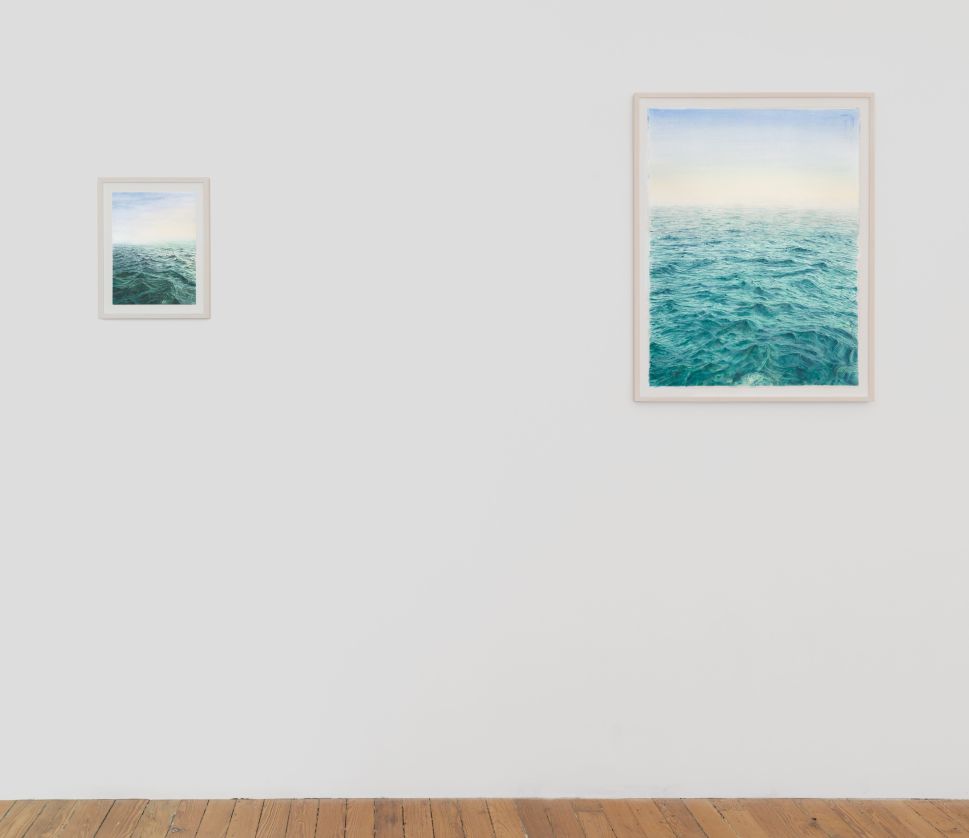On the second day, God separated the sky from the water. For Julia Felsenthal’s second solo exhibition, “Low Visibility,” she made twenty-four small to medium watercolors of horizons, also separating the sky from the water. Her experience of being lost at sea for four hours on a foggy day off Cape Cod led her to think about primal terror—fear and awe of biblical or Homeric proportions. Once safely back in her studio, her brush with danger inspired her to work with brush on paper, downplaying individualistic tendencies. Felsenthal, a writer, eventually drew upon others, namely Emily Wilson’s translation of the eponymous homecoming tale, The Odyssey, to supply the names for about half of her paintings. The Lotus-Eaters, Scylla and Charybdis each make their appearance. In No man’s land’s (Ithaca), steady and velvety strokes emit light as if portraying the Ionian Sea.
Other paintings sweep across the ensuing millennia. Mercator’s Projection presents an expanse of water with no land in sight. The title refers to a cartographical method that distorts the size of landmasses to maintain accurate compass bearings, contrasting precision and uncertainty. Without the title, the painting itself would be quite open-ended. Felsenthal repeats “v” like brushstrokes moving directionally towards a horizon formed of many slightly curved lines hinting at the earth’s curvature, yet blocking the v’s with videogame-like maneuvering. The arrow-like chop in the water painted in the foreground implies a voyage or buoy as if it is an odyssey of the soul or the body. If the viewer is considered to be in the place of the ship or the buoy, a walk through the gallery becomes part of the journey. To be sure, seeing these in person is a wholly other experience. At this threshold, one can witness Felsenthal’s scrapes, exposing the innards of the paper’s bleached cotton core, mimicking the glisten of water. A few other paintings translate the glistening in glitter. Such details are otherwise missed.
Felsenthal’s series strips down the seascape, reminding us that the horizon is a timeless trope, connecting paintings through the centuries. The edges of the paintings teem with pigment, while the centers remain sparse. In Boundless Sea, the paper becomes the boundary between sky and sea, while the sea is rendered with illuminated manuscript-like detail.
The paint often takes on a life of its own. In The Acheron, she portrays the sun with a glowing circle of dried watercolor—an iridescent version of the stain left on a table by a glass of water. Letting the paint do its thing evokes the exacting restraint of Arthur Dove’s suns and moons. Felsenthal’s varied facture ranges from Northern Renaissance to fluid modernism, again suggesting the expanse of her theme.
SEE ALSO: This Exhibition of George Loudon’s Collection in Venice Resurrects the 17th-Century Wunderkammer
The largest painting towers over the others, like Gulliver in Lilliput. Entitled Lashed to the Mast, it recalls Odysseus tied to resist the sirens’ song while his crew, ears sealed with wax, row on unbothered. This piece stands apart from the rest of the series: the jarring Arches paper logo contrasts with the clean sheets of the other paintings, its presence only heightened by pooled paint. The logo oddly echoes the absurdity of Felsenthal, lost at sea, snapping thousands of iPhone photos during her ordeal.
J.M.W. Turner famously tied himself to a mast so he could depict the most terrifying storm. In contrast, Felsenthal’s rousing titles accompany very moderate seas.
In Lashed to the Mast, she subverts the clean precision of taped edges with a final layer of paint, making perfection futile. While circles, swirls and crisscross marks of a serious sort appear throughout the exhibition, she here transforms them into something more wonky, creating a fissure with her more typical attempt to capture water realistically—much like Sylvia Plimack Mangold’s dry humor when painting landscapes and trompe l’oeils of taped off edges. The fidgety doodles capture the hallucinatory and nervous moments, the full spectrum of emotions before and after (not during) a storm. Nonetheless, her titles exude the calm of a long literary heritage. Such steadiness in a storm may be the only way through acts of folly or hubris.
“Low Visibility” is on view at JDJ through February 1.

